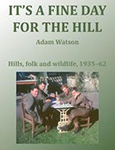Adam Watson can surely lay claim to being a true ‘Mountain Man’ of Scotland – perhaps the premier contemporary claimant to this auspicious title!
Adam Watson’s recently published ‘It’s a fine day for the hill‘ (subtitled ‘And once in a blue sun and moon’, the meaning of which is explained in the book) is his personal memoir of mountain exploits (especially in the Cairngorm and Mounth regions of the Scottish mountains) in the years from the 1940s to the early 1960s and the people he has known. In his time he has been a young amateur naturalist, a gillie, a student and researcher, a bird-watcher, a hillwalker, a rock climber, a mountaineer, a cross-country skier, a writer and an environmental scientist.
Perhaps the most interesting sections of the book are those that detail his close friendships with four individuals who have become icons in the history of the various types of activities that have been carried out by people in the mountains of Scotland in the 20th century, and are also well-described as ‘Mountain Men’: Seton Gordon, Bob Scott, Tom Weir and Tom Patey.
It is fascinating for modern readers who are perhaps only familiar with the places talked about in this book (particularly the Cairngorms) as hillwalkers to see how places like Rothiemurchus and Glen Lui used to be, before they changed from managed and farmed estates to the walking and skiing playgrounds, national parks and nature reserves they are today.
Particularly captivating are his accounts of youthful and penniless expeditions to Iceland and Norway (a much more serious undertaking in the days before cheap air travel and organised tourism) and long-distance solo cross-country skiing expeditions across the Cairngorm mountains, when this was still an entirely novel (and potentially dangerous) undertaking.
Adam Watson shows with many examples of his youthful exploits in the mountains in this book his personal philosophy of exploring and adventure, which is that “Exploration by one’s own free will is best pervaded by humility and wonder” and “Those who behave as if alone on an icecap when nobody else knows where they are and no help is possible, have greater inherent safety”.
Many things have changed since the years recorded in this book, in particular his individualism and self-reliance is somewhat out of fashion and counter to prevailing contemporary ideology that seems to stress safety and human-centred nanny-state ‘management’ above all else – perhaps to the detriment of the experience of the outdoors.
Other things give an indication of changed times and attitudes, particularly his recounting of raiding birds’ nests for eggs whilst a boy and on a trip to Iceland whilst a teenager, and also his almost casual accounts of Bob Scott shooting goosanders, foxes and a wild cat in Glen Lui. Within the circumstances of the time (the years of the Second World War and directly afterwards) these were not irresponsible and ill-informed activities but to modern sensibilities they might be surprising.
The large format of the book allows for the inclusion of many photographs from Adam’s collection, many unusual in being in colour and of high quality, from an era before taking cameras into the Scottish mountains was common.

Eddie
There is an article on the BBC news website about Adam Watson here:
http://www.bbc.co.uk/news/uk-scotland-highlands-islands-16980547
Eddie
And an article on the Scotsman website here:
http://www.scotsman.com/scotland-on-sunday/scotland/peter_ross_meet_the_81_year_old_polymath_at_one_with_nature_1_2125185
Eddie
And a video of an interview on the STV website here:
http://local.stv.tv/aberdeen/news/298196-scientists-life-work-in-the-cairngorms-recognised/